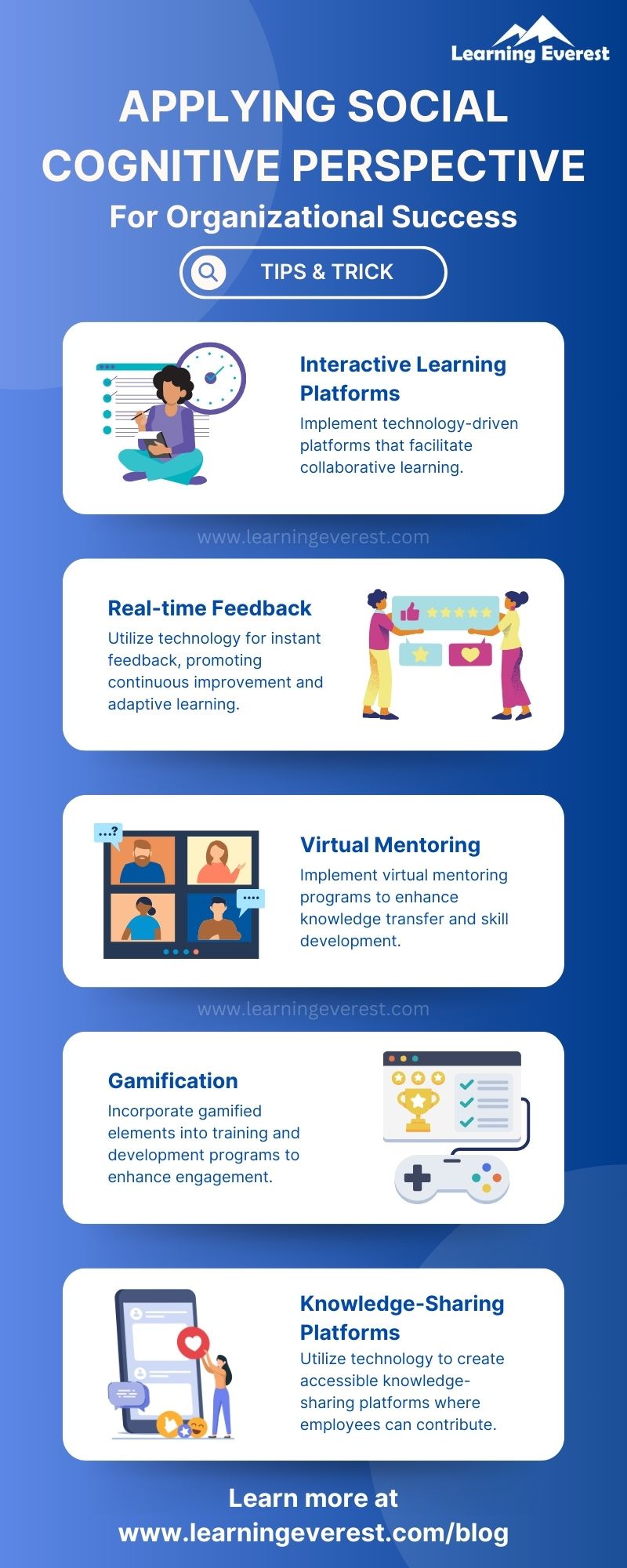In the realm of corporate learning and development, the influence of social cognitive theories is significant. In this blog, we discuss what the social cognitive perspective is, explore the theory’s various concepts, review how organizations can apply them using collaborative learning, discover cognitive learning strategies, and share their benefits.
Table of Contents
- What is the social cognitive perspective?
- Applying Social Cognitive Perspective to Corporate Learning and Development
- Cognitive learning strategies
- Social cognitive perspective benefits
- A few ways to incorporate social cognitive perspective
- Infographic
- Knowledge Check!
- Frequently Asked Questions (FAQs)
- What are social cognitive theory examples?
- What is the basic concept of social cognitive theory?
- How does social cognitive theory explain the influence of role models on behavior?
What is the social cognitive perspective?
The social cognitive perspective explores how various social interactions can affect learning cognition. The approach often examines how people adjust their behavior to build goal-directed habits. The social cognitive perspective assesses an individual’s actions over time instead of observing how someone begins their behavior, similar to other learning theories.
Concepts under social cognitive theory include:
- Positive and negative reinforcement: Positive or negative responses, such as rewards or punishments, can impact future learning behaviors. In corporate training, positive reinforcement involves acknowledging and rewarding employees for achieving goals or displaying desired behaviors. For example, providing recognition or bonuses for meeting sales targets encourages a positive learning attitude.
- Reciprocal determinism: A person, their environment, and behavior can all interact and influence each other. Reciprocal determinism in a corporate setting emphasizes the dynamic interplay between employees, their work environment, and their behaviors. For instance, a supportive work culture can enhance employee motivation and productivity, leading to a positive reciprocal relationship.
- Observational learning: Learners can observe others perform an action and repeat the behavior themselves. Observational learning in corporate training occurs when employees observe successful colleagues demonstrating effective practices. This can include shadowing experienced team members or participating in workshops where skills are demonstrated and then applied.
- Self-regulatory capability: A person’s ability to control their behavior, even in unfavorable environments. Self-regulatory capability is crucial in a corporate context, where individuals need to control their behavior even in challenging situations. For instance, an employee with strong self-regulation skills may stay focused and composed during a high-pressure client presentation.
- Emotional coping: Good coping mechanisms people can use against stressful environments and negative personal characteristics may lead to effective learning. Emotional coping skills are vital for effective corporate learning, enabling individuals to manage stress and negative aspects of their work environment. For example, providing employees with resources like mindfulness workshops can foster emotional coping mechanisms, contributing to a healthier and more productive workplace.
Applying Social Cognitive Perspective to Corporate Learning and Development
In corporate settings, fostering employees’ perceived self-efficacy is crucial for motivation, engagement, and overall performance. When individuals believe in their ability to succeed in professional development, they are more likely to persist in learning and invest greater effort in acquiring new skills. Just as in education, understanding reciprocal determinism and the interaction between environment, cognition, and behavior provides valuable insights for shaping effective training practices. Here, as well, self-efficacy acts as a driving force, propelling employees toward their career goals.
Social cognitive perspective underscores the impact of personal factors and environmental influences on learning experiences. In the context of corporate training, organizations can apply these principles to design programs that enhance employees’ belief in their capabilities, promote personal control, and facilitate skill development.
Cognitive learning strategies
The following shows how companies can use social cognitive perspective strategies in their learning environment:
Learner-centered approach
Learning is a relative and cumulative experience for each person. When learning, individuals can start with a basic knowledge foundation and learn from that point. When using a social cognitive perspective, trainers can create a safe learning environment, a place where they can nourish the learner’s curiosity and welcome their insights. For learning and development managers, this might mean focusing on how they structure a training program. The following details of the learner-centered approach suggest that accommodation, assimilation, and equilibration are essential to learning:
- Accommodation: How people change what they already know to consider new knowledge.
- Assimilation: How people arrange new knowledge alongside what they already know.
- Equilibration: The balance between what people already know and what they’re currently learning.
Learning through discovery
A core feature of the social cognitive perspective is active learner involvement. Instead of giving individuals information, trainers can allow them to discover the information themselves. Ensuring individuals have a conceptual understanding of a topic is more essential than how they gain information. Interaction is the key here. In the workplace, trainers can use this strategy by giving employees an opportunity to complete tasks to enhance their learning and asking them to solve real-world challenges during training.
Creating meaningful experiences
This strategy focuses on the belief that trainers can attempt to make learning meaningful to help the learning be permanent and effective. Relatable material, which fits perfectly with what the individual already knows, is significant, which makes it effective. This means that before showing individuals complex material, the trainer can develop some introductory material or provide some background to the topic. When an individual has the relevant background knowledge of a complex subject, it is easier for them to relate to the new information.
Social cognitive perspective benefits
The following are the benefits a company can experience when using cognitive learning strategies for their employees:
- Increases comprehension: Cognitive learning promotes hands-on learning, where individuals get their knowledge by exploring the surrounding environment. If they get the information by doing this, it is easier to apply the materials to future company challenges.
- Increases confidence: Individuals can feel more confident in their abilities to solve complex company challenges because the training helps them to prepare. They can continue to learn and develop their previous knowledge by solving problems using the information they learn during training.
- Promotes lifelong learning: Developing cognitive skills helps individuals to build on their previous ideas and knowledge. This can help the individuals learn to make connections and apply new information to what they know.
- Develops problem-solving skills: Cognitive learning teaches individuals the skills they require. This can help the individual build problem-solving skills they can use for any challenge.
A few ways to incorporate social cognitive perspective
Here are ways to incorporate a social cognitive perspective into corporate learning and development:
- Provide role models: Showcase success stories within your organization to inspire your employees and demonstrate how others have successfully navigated similar development paths before.
- Encourage collaborative learning: Foster a supportive environment where employees can learn from each other, share experiences, and collectively build confidence in their capabilities. Collaborative learning cultures provide positive reinforcements that can encourage employees to get more knowledge.
- Offer constructive feedback: Provide timely and constructive feedback to your employees to gauge their progress, reinforcing their sense of competence and encouraging continuous improvement.
- Simulate real-world scenarios: Develop training modules that mirror actual work situations, allowing your employees to apply newly acquired skills in a controlled environment, building both confidence and competence.
- Set realistic goals: Create achievable learning objectives to boost employees’ confidence in their ability to acquire new skills and knowledge.
These can create a corporate learning culture that empowers employees, boosts motivation, and enhances overall professional development.
Infographic

Applying Social Cognitive Perspective for Organizational Success
Knowledge Check!
Frequently Asked Questions (FAQs)
What are social cognitive theory examples?
The examples of social cognitive theory include learning through observing others, such as children imitating their parents or individuals acquiring new skills by observing and emulating competent role models.
What is the basic concept of social cognitive theory?
The basic concept of social cognitive theory involves the interplay of cognitive processes, behavior, and environmental influences in the learning and development of individuals.
How does social cognitive theory explain the influence of role models on behavior?
Social cognitive theory posits that individuals learn by observing others. Role models serve as examples, and through imitation, individuals adopt behaviors, values, and skills demonstrated by these models.






